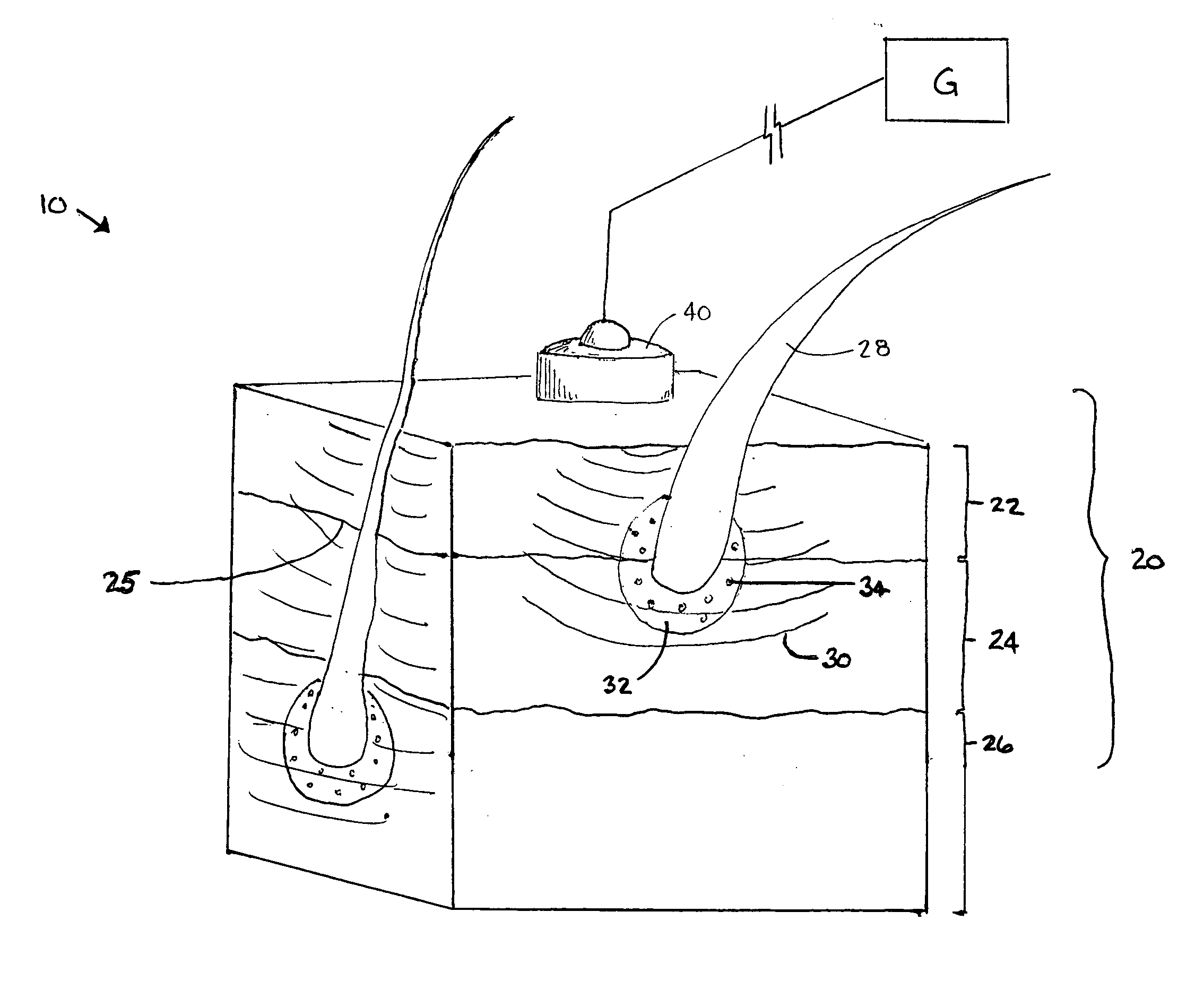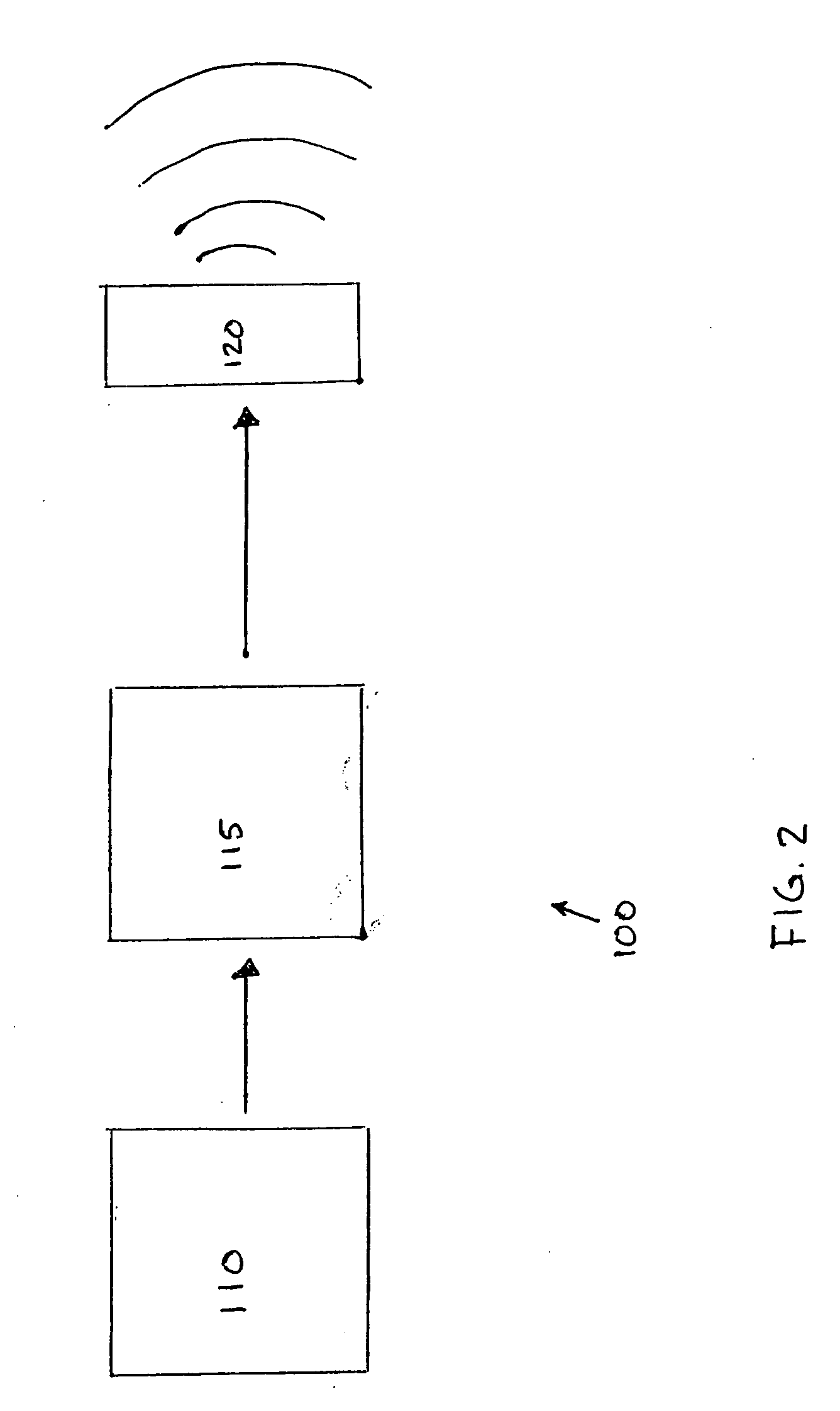Ultrasound-based treatment methods for therapeutic treatment of skin and subcutaneous tissues
a technology of ultrasound waves and skin, applied in the field of ultrasound-based treatment methods for skin and subcutaneous tissues, tissue treatment methods using ultrasound waves, can solve the problems of hair follicle disruption, high cost, complicated skin treatment, etc., and achieve the effects of reducing the risk of infection
- Summary
- Abstract
- Description
- Claims
- Application Information
AI Technical Summary
Benefits of technology
Problems solved by technology
Method used
Image
Examples
example 1
Cavitation Studies
[0088] A study on the cavitation threshold and activity in pure water and in water containing poly(lactic-co-glycolic acid) (PLGA) nanoparticles as well as in vivo in nude mice. FIGS. 4A and 4B illustrate the cavitation signals obtained at the same ultrasound pressure from pure water (4A) and from containing PLGA nanoparticles (4B), respectively. As is readily apparent from these figures, the cavitation signal obtained from water with PLGA nanoparticles was significantly greater. The signals were integrated using a procedure described in detail in the article by Larina, I. V., et al., [Technol Cancer Res. Treat., Vol. 4(2): pp. 217-226 (2005)] to measure cavitation activity at different pressure (cavitation activity is proportional to concentration of cavitation bubbles and strength of individual cavitation events). In further tests, and as illustrated in FIGS. 5A and 5B, cavitation activity was measured in both pure water (FIG. 5A) and in water containing PLGA na...
example 2
In Vivo Studies
[0090] In the in vivo experiments, Optison™ (Amersham, Mallinkrodt) or PLGA nanoparticles were injected into the tail vein of nude mice and the cavitation signals and activity were measured using the same approach as used in the experiments with water, described above. FIG. 6A shows cavitation activity measured from the subcutaneous tissue of a mouse injected with Optison™ prior to irradiation. As can be seen from the photomicrograph, cavitation activity can be detected with a threshold of about 48 bar.
[0091] However, the cavitation activity decreased rapidly due to degradation of Optison™ upon ultrasound irradiation. Injection of another mouse with PLGA nanoparticles also induced cavitation activity in the irradiated tumor (with almost same threshold), as shown in FIG. 6B. However, the PLGA nanoparticles produce stable cavitation for a longer time because they degrade at a much slower rate. These studies demonstrate that PLGA nanoparticles: (1) substantially lower ...
example 3
Ultrasound-Induced Tissue Damage Studies
[0092] In addition to the benefits of can induce precise damage in multiple areas of tissue at a desired depth using such a system. FIG. 7A shows ultrasound-induced damage in multiple areas at different depth from the skin surface and lateral locations. The single areas of damage have millimeter or submillimeter size. FIG. 7B shows a damaged area with a submillimeter width and one-millimeter length. This size and depth of the damage areas is desirable for treatment of skin and / or subcutaneous tissues (e.g. skin rejuvenation) and cannot be achieved at depths greater than 0.5 mm with standard laser- (or in general, light-) based techniques / systems. The ultrasound beam can be moved laterally over the skin surface to produce desirable pattern of damaged areas at the desired, subcutaneous depths.
PUM
 Login to View More
Login to View More Abstract
Description
Claims
Application Information
 Login to View More
Login to View More - R&D
- Intellectual Property
- Life Sciences
- Materials
- Tech Scout
- Unparalleled Data Quality
- Higher Quality Content
- 60% Fewer Hallucinations
Browse by: Latest US Patents, China's latest patents, Technical Efficacy Thesaurus, Application Domain, Technology Topic, Popular Technical Reports.
© 2025 PatSnap. All rights reserved.Legal|Privacy policy|Modern Slavery Act Transparency Statement|Sitemap|About US| Contact US: help@patsnap.com



